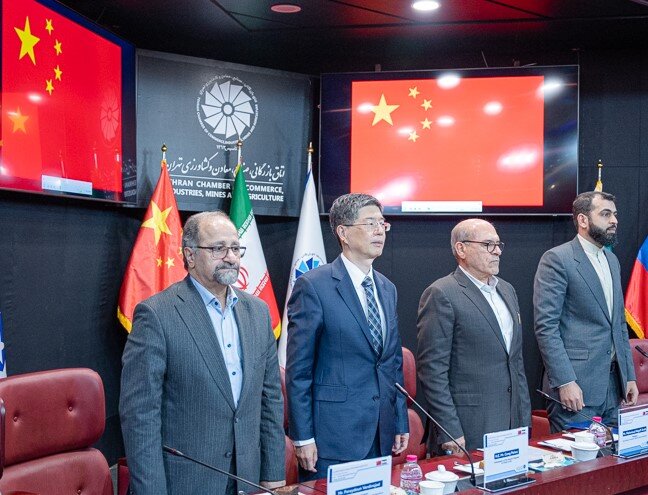Tehran Chamber of Commerce hosts Iran-China business development forum

TEHRAN - The Iran-China Business Development Forum convened at the Tehran Chamber of Commerce, Industries, Mines and Agriculture (TCCIMA), with the participation of China’s ambassador to Iran, the head of Iran’s Trade Promotion Organization (TPO), the chair of the Iran-China Parliamentary Friendship Group, and senior officials from the Tehran Chamber.
A large number of business leaders from both countries attended the event, where state, legislative, and private-sector strategies for deepening bilateral trade ties were outlined, the TCCIMA portal reported.
Opening the event, TCCIMA Head Mahmoud Najafi Arab welcomed Chinese delegates who traveled to Iran for the Iran Expo. He expressed gratitude for the Chinese ambassador’s continued efforts to expand economic ties between the two nations.
Najafi Arab said Iran and China share thousands of years of cultural and commercial relations, which have entered a new phase in recent decades, marked by growing partnerships across multiple sectors. He said the two countries could serve as a model for sustainable cooperation based on mutual respect in today’s increasingly interdependent world.
He also highlighted recent visits of Iranian private sector delegations to various Chinese provinces and exhibitions, emphasizing the need to identify investment opportunities and facilitate financial exchanges. The Chamber, with over 140 years of history, is prepared to host expert meetings, present economic opportunities, support joint ventures, and activate professional networks between Iranian and Chinese businesses, he said.
China’s Ambassador to Iran Cong Peiwu, thanked Iranian participants and the Tehran Chamber for organizing the event. He expressed hope that the forum would help strengthen bilateral trade and economic cooperation.
Referencing the recent meeting between the two presidents at the BRICS summit in Russia, Cong said China is fully committed to enhancing cooperation across all sectors in ways that benefit both peoples.
Iran-China ties aligned with Iran’s Seventh Development Plan
Also speaking at the forum, Ruhollah Nejabat, chair of the Iran-China Parliamentary Friendship Group, said Iran’s non-oil exports to China surpassed $14.8 billion last year, making China the largest destination for Iranian goods and accounting for about one-quarter of Iran’s total non-oil exports. Imports from China reached approximately $19.3 billion, or 27 percent of Iran’s total imports, making China Iran’s second-largest import partner after the United Arab Emirates.
These figures, he said, demonstrate the resilience and strategic importance of Iran-China trade, even amid global economic slowdown, with both countries supplying a significant portion of each other’s needs.
Nejabat noted that Iran’s Seventh National Development Plan emphasizes industrial modernization and attracting foreign capital and technology. He said Iran aims to upgrade its industries—from automotive and textiles to pharmaceuticals and medical equipment—and that this will be achieved more quickly with partners like China, now a global industrial superpower.
He added that technology transfer and joint investment are two strategic priorities for Iran. Chinese firms, he said, could take advantage of Iran’s market size and skilled labor to establish production lines and access broader regional markets.
Conversely, Iran could supply intermediary goods and industrial components needed by Chinese industries. Nejabat said Iran will offer special incentives for foreign industrial investment and provide a secure legal environment for Chinese companies. Infrastructure development—including rail networks, highways, and ports—is also a priority, and many of these projects will require Chinese expertise and participation.
He also pointed to Iran’s largely untapped mining sector, including vast reserves of iron, copper, aluminum, and rare earth elements, as an area ripe for development and export growth.
Four trade promotion strategies for expanding Iran-China economic ties
Speaking at the forum, Mohammad Ali Dehghan Dehnavi, head of Iran’s Trade Promotion Organization (TPO), outlined four key strategies for expanding trade with China. The first is technology transfer. He said Chinese companies have made major investments in research and development, much of which has not yet been fully commercialized. Iran, as a long-time partner, seeks deeper collaboration in these cutting-edge sectors.
The second strategy, he said, is increasing trade in high value-added goods. Currently, much of the bilateral trade consists of raw or semi-processed materials. The average value of Iran’s exports stands at less than $400 per ton. “We want to change that,” he said, calling on Chinese importers to prioritize Iranian products with higher added value. He welcomed the Chinese ambassador’s praise for the competitiveness of Iranian nanotechnology and biotechnology products.
The third strategy is joint production through co-investment. Dehnavi said Iran offers a secure investment climate, with legal guarantees allowing foreign investors to repatriate both capital and profits. “There are many documented cases of investors successfully exiting after profitable ventures,” he said.
Iran offers highly competitive costs, a wide range of investment opportunities, and strong security for foreign capital, he added, expressing hope for increased joint ventures with Chinese firms.
The fourth strategy is mutual market access. Dehnavi said Iran produces many goods that are well-suited for the Chinese market and that joint production could also help both countries expand into third-country markets. “This kind of cooperation can make our trade ties deeper and more sustainable,” he said.
TCCIMA signals full readiness to support Iran-China business growth
Fereydoun Vardinejad, secretary general of the Tehran Chamber of Commerce, said China had stood by Iran during both stable and turbulent times, and that the two peoples share a strong emotional bond.
However, he warned that a lack of information exchange and mutual understanding of economic capacities had led to a wide gap between political relations and economic realities. “Our ties are excellent in potential but need significant work in practice,” he said.
Vardinejad called for a “win-win partnership” and proposed several actions: holding specialized business meetings, promoting bilateral trade missions, introducing market opportunities, ensuring trade balance, and supporting private-sector cooperation in areas like creative industries, digital economy, nanotechnology, and biotechnology.
“These steps,” he said, “can build deeper and mutually beneficial ties between Iran and China.”
EF/MA
